Kombucha - Brewed with Lemon Balm Herbal Tea (no caffeine)
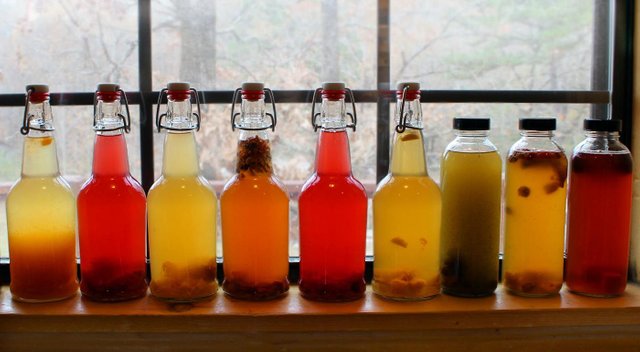
You never forget the first time when kombucha hits your tongue. This bubbly, slightly sweet and sour fermented tea is delicious. My husband and I first encountered kombucha on a trip to Houston and we were hooked instantly. We purchased a cooler full of them to bring home with us. And at $5 a bottle, it was a sizable dent in our wallets.
My husband has always had digestive issues, especially stomach gas. You know, the kind that makes you bloat and burp. He soon found out a drink or two of Kombucha helped him relieve gassy conditions that he could never eliminate before. So, knowing it helped him with stomach gas, I decided to look further into it's benefits and availability. Since we lived in a rural area and there was no kombucha to be found (there is now), I decided to learn how to brew kombucha at home and purchased "The Big Book of Kombucha".

What is kombucha?
Traditional kombucha is a beverage made with fermented sweetened black or green tea with SCOBY (symbiotic culture of bacteria and yeast)
By reading the Big Book of Kombucha and doing a little research online, I quickly learned of the benefits kombucha can have on the body:
Kombucha can help populate the gut with good bacteria and B-vitamin-rich yeast, lower the PH of the stomach, and jump start digestion and nutrition absorption with a number of healthy acids and enzymes.
Kombucha's immune boosting properties begin with digestive function support in the form of living organisms and healthy acids, enabling the body to more effectively protect itself.
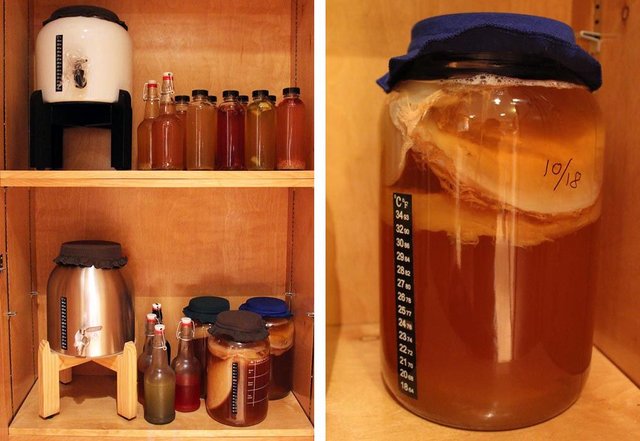
It's easy to brew kombucha at home. There is plenty of free information online about brewing traditional kombucha with black, green, or white tea. We try to limit our caffeine intake and soon realized drinking kombucha after dinner would affect our sleeping schedule. Even though there was only a small amount of caffeine left in the finished brew, it, along with the energizing effects of kombucha gave us a little too much energy. So, I researched brewing with herbal tea, but information was quite limited. So, I decided to do my own brewing experiments.
My herbal tea kombucha experiments
I started several one gallon brews with different non-caffeinated herbal teas and quickly found the reason kombucha was usually brewed with traditional tea. It was due to many herbal teas having high amounts of volatile oils and a SCOBY would not survive the brew.
I have encountered plenty of dead SCOBYs in my own herbal tea experiments. Here is what I've found:
Comfrey, peppermint, St. John's wort and chamomile have too much volatile oils. The SCOBY died in the brews with these herbal teas.
Lemon balm, nettle, hibiscus flower, dandelion and raspberry leaf make good herbal tea kombucha without caffeine. My personal favorite is lemon balm by far! It has a slight lemony flavor, almost like a watered down lemonade. So refreshing and delicious!
I am not going to tell you about how to brew kombucha the traditional way with black or green tea here. There is plenty of information online about that. I am going to tell you how I brew kombucha with lemon balm herbal tea.
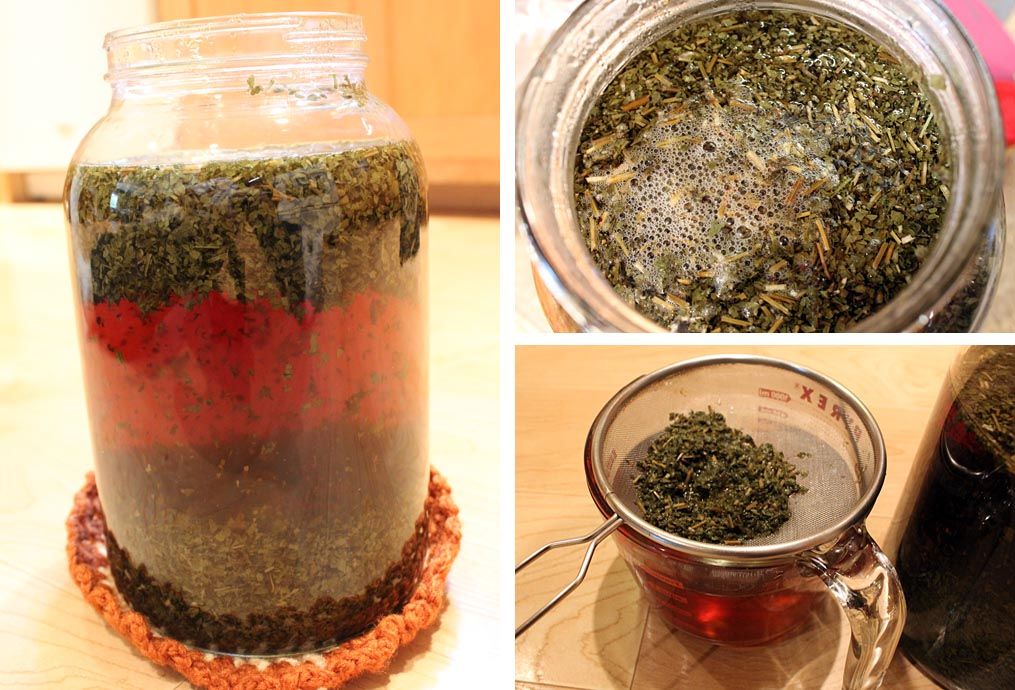
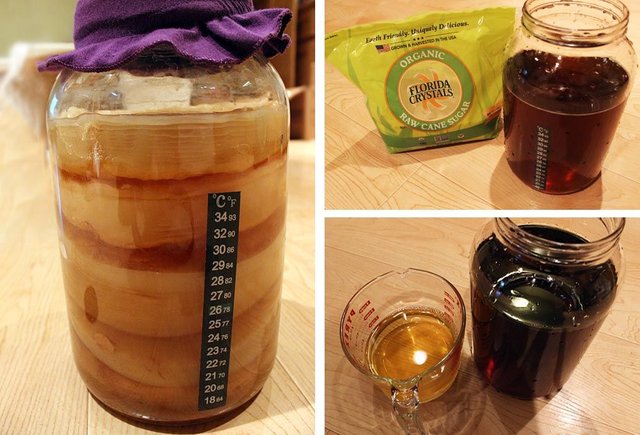
How I brew lemon balm herbal tea Kombucha at home
First fermentation:
- I start my kombucha brewing process by steeping a little over 2 cups of dried lemon balm leaves with hot (just under boiling) water in a gallon glass jar for about six hours. I found that during my experiments with herbal teas, if I don't brew a full strength lemon balm tea, the finished kombucha can taste a bit too watered down, so make sure not to dilute with water and brew full strength.
- Strain the leaves. This usually gives me about 12 cups of lemon balm tea. I typically use 10 cups in the gallon jar and just drink the additional two cups. I add one tablespoon of organic cane sugar for each cup of lemon balm tea. Stir until sugar is completely dissolved. (Don't worry, the sugar is food for yeasts during the fermentation process, so by the time both fermentations are done, not much sugar will remain for you to consume.)
- Tea should be cool enough (somewhere right above room temperature) after six hours of steeping. This temperature will be fine to add your SCOBY. Do not put a SCOBY in, unless tea is below 100 degree F. If tea is too hot, SCOBY will die. With clean hands, take a SCOBY out of the SCOBY hotel and put it in the ten cups of sweetened lemon balm tea.
- Gently pour a minimum one cup of starter liquid into the ten cups of lemon balm tea. It's important to keep the starter liquid at the top of the brew, so try not to mix your starter liquid in too much. By starter liquid, I mean at least six week old plain lemon balm kombucha with a PH of 3.2 or lower) By pouring it gently on top, you keep the lower PH starter liquid as a barrier between the higher, less acidic tea, and the air. This helps prevent mold from forming.
- Cover the jar with a breathable cloth. Do not use cheese cloth because fruit flies can get into your booch and cause mold. Set the glass jar in a warm place, about 75 to 85 degree F and out of direct sunlight.
- Let the sweetened lemon balm tea ferment for five to seven days. Fresh air is occasionally needed if you are brewing in a closed in area like a closet. So make sure to open the door every now and then. Time varies on fermentation, depending on the temperature of the kombucha during the fermentation process. The lower the temperature, the longer the process takes to complete. You will notice a new baby SCOBY forming at the top of the jar. Start taste testing around day five.
- Once the brew reaches the flavor you like or the PH is 3.5 or lower, it's time for the second fermentation. This is when the fun starts! Don't forget to save a minimum one cup of this plain kombucha as starter liquid for your next batch. I take the starter liquid for the next brew from the top of the jar.
- Finished kombucha has a low PH. Use a PH tester that will show the lower range PH levels. The photo below shows the PH tester I use.
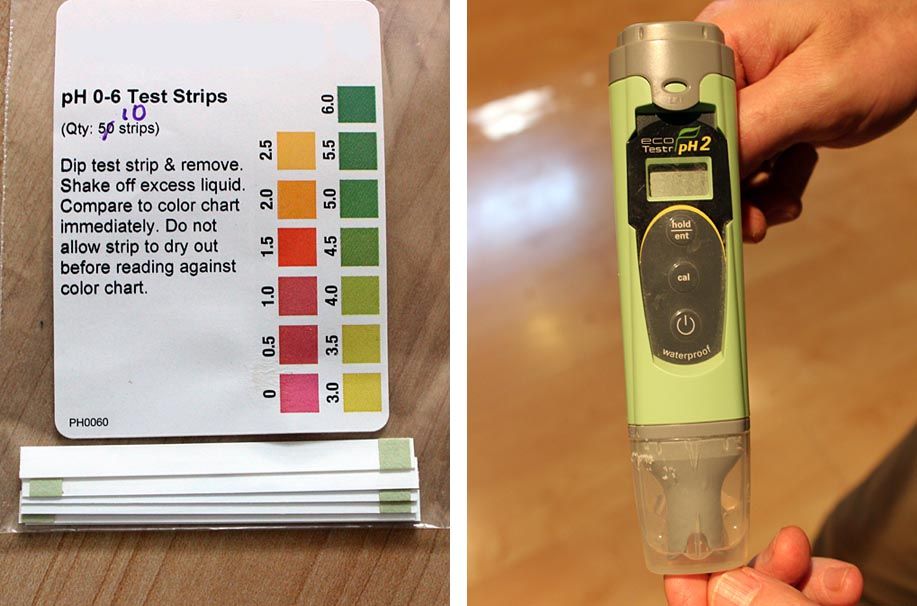
Second fermentation:
- Remove the SCOBY and set it in a clean bowl. Cover with a clean towel so no fruit flies can get to it. And remember to make sure you have already taken the starter liquid out prior to removing the SCOBY. Moving the SCOBY can stir up the yeasts at the bottom of the jar which is not as good to use as your starter liquid. (You can drink the kombucha at this point without even doing a second fermentation. This is considered plain or original kombucha)
- Now, some more fun. We bottle the rest of the liquid for a second fermentation so more flavor and carbination can develop. Add any flavor combinations you like to the bottles. I usually let the second fermentation last between three to five days, depending on kombucha temperature. More carbonation will be created during the second ferment.
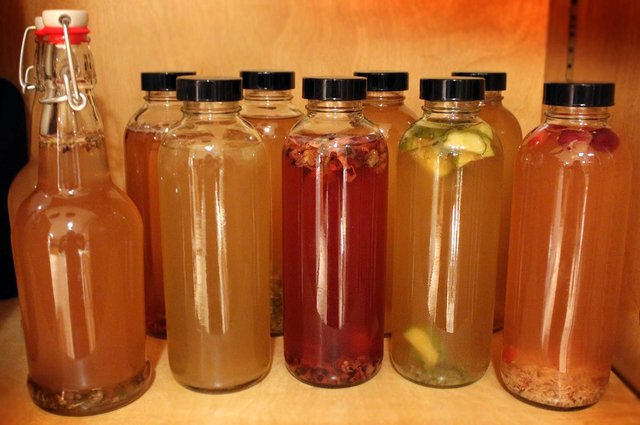
A few tips on the second fermentation
- Add a small amount of ginger (candied or fresh) and / or raisins to the bottles. This will to add carbonation and flavor. I usually put about 1/2 teaspoon of candied or fresh ginger and six raisins in each bottle.
- If you like your kombucha sweeter, try adding a date in the 2nd fermentation instead of sugar, it's better for you and it tastes great. It also adds a nice carbonation to the booch.
My personal favorite: blueberry + rose petals + lavender
(this flavor combination comes from "the Big Book of Kombucha". Being a professional artist for 12 years right out of college. I know how annoying it is when people don't respect my intellectual property. Therefore, to respect the author's work, I will not show the amount of each ingredient here. To find out, please purchase her book! Highly recommend her book if you want to learn how to brew kombucha at home.)Other flavor combinations we also love:
hibiscus + lemon
Rose hip + goji berries
Rose petals + rose hip + elderberries
Wheatgrass + spirulina + barely grass + chlorella
Wild blueberry + lemon + extra ginger
Apple + cinnamon
Cherry + extra ginger
lemon balm + mint + peachI have also had success with adding fresh lemon balm leaves, cucumber, and different herbs and flowers such as rosemary & calendula

A few tips for people who are new to kombucha
If you have never tasted kombucha and would like to give it a try, introduce it to your system slowly. Maybe two ounces at first and see how your body reacts after a few hours. If you like the way your body feels after consuming kombucha, then gradually increase the amount you drink. People have reported having a healing crisis when consuming too much kombucha, too fast.
If you decide to embark on the journey of brewing kombucha at home, keep in mind we can never control kombucha brews perfectly. It is a fermented tea and it's alive with bacteria and yeasts. Even if you have two identically prepared batches with the same brewing conditions, the finished batches may still taste and look different. But that's the fun of brewing kombucha at home and I get excited about tasting my final brew each and every time.
Do you brew kombucha at home? What are your favorite flavor combinations? Have you had experience with brewing with herbal teas? Please share your story with me.
This post is inspired by @riverflows and @lovenfreedom after reading @riverflows 's post on kombucha making and the conversation we had. You can read her post here: https://steemit.com/health/@riverflows/mighty-mighty-boosh-green-tea-kombucha-with-jalepenos-and-lime
I am so glad to find like minded people on Steemit! It's a community I am happy to be part of. If you like my post, please upvote, resteem and comment. I would love to hear your experience.
Photo copyright: @thelaundrylady
Wow very well done post ! Ill have to try this one day 🤤 i wanted to let u know that i found your post from @goldendawne resteemed it and i gave you my support🌺 i wish there was taste vision lol.
Thank you stopping by and thank you for your support! @goldendawne has been great in supporting the small fish on the platform. Really appreciate it!
Thank you both!!!
I am newer to the fermenting and love to share when I see someone using this process. It was a great post!
Thank you so much @goldendawne! Sometimes I am not sure anyone is interested in reading the things I am writing. Thank you for resteeming my post. I am pretty sure I got a few new followers because of you. Really appreciate it!
You're so welcome! And YES I do love reading your posts.I may not always comment but I do try to UPvote when I can.
Very nice. I love kombucha. My parents have tinkered with it before. The scoby always kind of freaks me out, but it is interesting at the same time. I have had off and on digestive issues. I have what I consider a sensitive stomach. I don't drink kombucha regularly, although I probably should, but what heals me is fennel tea. Like magic, the fennel soothes all digestive ails.
I will have to tell my husband about fennel tea! Thanks for the info. I have not heard of it helping with digestive issues. SCOBY does have interesting texture. I think it feels like raw chicken, but it's been almost 10 years since I touched raw chicken, so my sense might be wrong.
Lovely post and very detailed too! The variety of colors of the bottles in your picture are stunning! I feel the urge to go try and make some now. I've never even really heard of Kombucha until reading your article. Thank you so much for sharing this. ❤
Thank you! We love kombucha. It must be getting more popular because even our rural grocery store is now carrying a few different kinds. It's wonderful stuff for the guts! If you decide to try it, purchase from a store first and drink only 2 ounces first and see how your body reacts.
fantastic post! this would've been great for an #ocd-resteem! @ocd! haha what a great post; i hope you get curated and upvoted! <3 resteemed @the-hearth, @mountainjewel's earth-centered curation account.
Thank you for your kind words! Glad you stopped by!
This has totally rocked my morning!! It's totally amazing and I really appreciate you for sharing as I haven't found decent info on making herbal tea boosh on the net so far, and this is incredibly informative. I'm bookmarking it on Busy to come back to so I can make my own herbal tea boosh. I'd love to try the lemon balm one and i will do but I have to find a supply - for some reason my hubby HATES it and couldn't bear it in the garden! It's like kryptonite for him haha. Definitely resteeming it! :) xxx
Hey, your response made me very happy to have done this post and I am glad you found this helpful! Like you said before, some things are second nature to us, so we don't even think about posting detailed instructions for it. I never thought about posting this until you mentioned it, so thank you for the idea! Never thought other people would be searching for kombucha brewed with herbal tea like I was.
I promise you if you brew kombucha with lemon balm herbal tea, you would love it. It tastes light and lemony. You could always purchase dried lemon balm leaves from health food stores or online herbal shops even though you don't have your own lemon balm plants.
You could also use nettle leaves if you have it growing on your property. The finished brew tastes darker and more herbal in a way. Again, thanks for the inspiration for this post!
I have never had it, but would be very interested in trying it.
I have not done the extensive research and experiments that you have @thelaundrylady, but I am a little confused. I thought kombucha was the symbiotic relationship between the bacteria and yeast (which then makes the scoby or mother). One eats the sugar and the other eats the brewed black tea. It makes me wonder what is happening (what different chemical reactions are occurring) during the herbal brewing process that is different from the traditional kombucha with black tea.
I love all the ideas that you provide plus experiential knowledge....but I just cannot wrap my mind around the fact that you have "kombucha" without black tea.
P.S. Again, I am no expert: I did start making my own home brew back in the early 2000's, when the government wanted to regulate kombucha. They were afraid that young people might want to drink it because of the (minuscule amount of) alcohol. All that potential regulation did was cause folks to make it themselves which is so empowering.
Love to hear how the government's plan backfire on them. That is empowering indeed! People used to think SCOBY needs caffeine to survive, but it's not true. Yeasts do need sugar as food, so substituting sugar is a bad idea, but more information has come out about the caffeine part. The reason kombucha brewing was unsuccessful with some herbal tea was because of the volatile oil. When doing an experiment with herbal tea, if the same SCOBY can survive the kombucha brewing process a minimum of 10 times and form baby SCOBY every time, then the herbal tea is considered a viable option for kombucha brewing.
Good to know! Thank you.
Thanks! This helps a lot when I decide to experiment further. Pretty cool that I don't have to sacrifice SCOBY for the mint tea.
If someone else is reading this, thelaundrylady advised to use some mint leaves on 2F to get the mint flavor.
Thank you for stopping by @lovenfreedom! Try the mint leaves for Summer time kombucha in 2F. It is so refreshing!
I just love Kombucha. We always have a batch brewing at our home. Lemon balm sounds amazing!
wow...this is an absolutely gorgeous post!!!!!! we've been brewing for a about ten years...and i just learned a TON!!!!! the images alone....made my stomach flora do a back flip .....in joy!!!! re steemed!
Thank you so much! I am glad to be able to share what I have learned and to know other people find the information helpful made it all worth it to me! Thanks for stopping by.